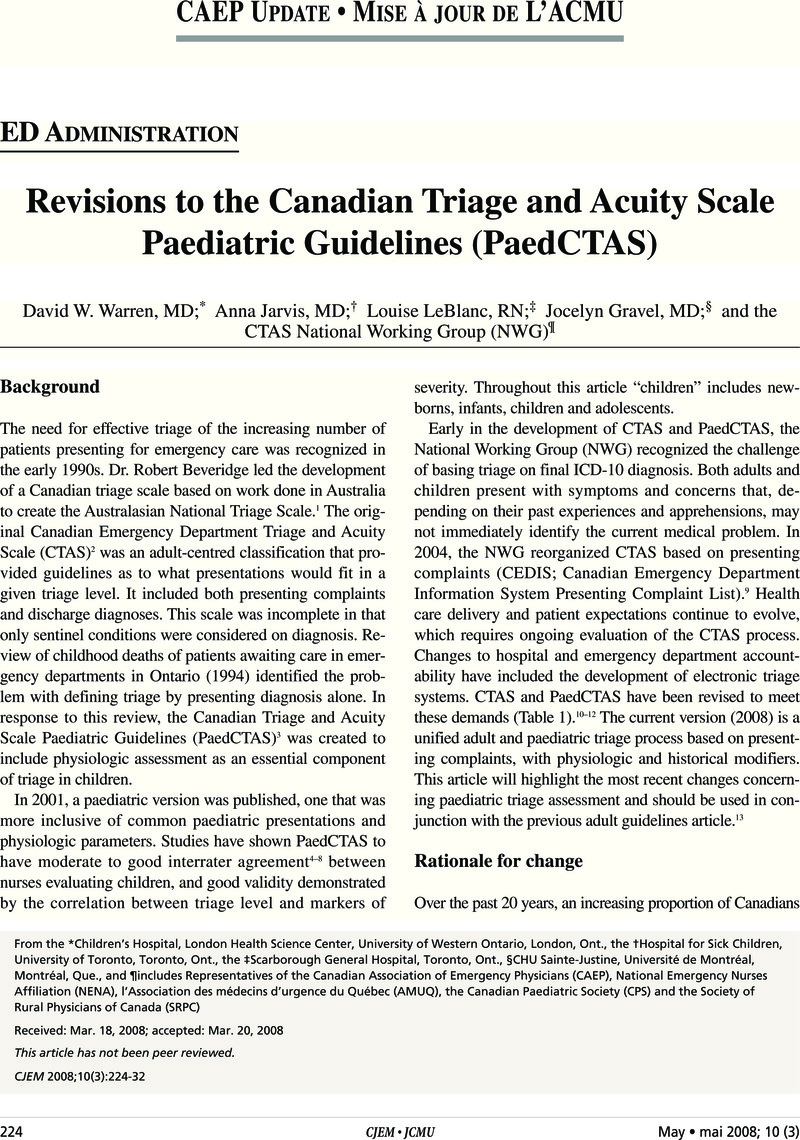Crossref Citations
This article has been cited by the following publications. This list is generated based on data provided by Crossref.
Gravel, Jocelyn
Manzano, Sergio
and
Arsenault, Michael
2009.
Validity of the Canadian Paediatric Triage and Acuity Scale in a tertiary care hospital.
CJEM,
Vol. 11,
Issue. 01,
p.
23.
García, Santos
Rubio, Mercedes
and
Ruiz, José Antonio
2009.
El proceso de clasificación.
Anales de Pediatría Continuada,
Vol. 7,
Issue. 5,
p.
247.
Considine, Julie
Thomas, Shane
and
Potter, Robyn
2009.
Predictors of critical care admission in emergency department patients triaged as low to moderate urgency.
Journal of Advanced Nursing,
Vol. 65,
Issue. 4,
p.
818.
Gravel, J.
Manzano, S.
Guimont, C.
Lacroix, L.
Gervaix, A.
and
Bailey, B.
2010.
Validation multicentrique du score clinique de déshydratation pédiatrique.
Archives de Pédiatrie,
Vol. 17,
Issue. 12,
p.
1645.
Hamm, Michele P.
Osmond, Martin
Curran, Janet
Scott, Shannon
Ali, Samina
Hartling, Lisa
Gokiert, Rebecca
Cappelli, Mario
Hnatko, Gary
and
Newton, Amanda S.
2010.
A Systematic Review of Crisis Interventions Used in the Emergency Department.
Pediatric Emergency Care,
Vol. 26,
Issue. 12,
p.
952.
Christ, Michael
Grossmann, Florian
Winter, Daniela
Bingisser, Roland
and
Platz, Elke
2010.
Modern Triage in the Emergency Department.
Deutsches Ärzteblatt international,
Bauer, H.
and
Bruch, H.P.
2011.
Organisationsformen der Notfallmedizin aus Sicht der DGCH und des BDC.
Der Chirurg,
Vol. 82,
Issue. 4,
p.
326.
Gaucher, Nathalie
Bailey, Benoit
and
Gravel, Jocelyn
2011.
Who Are the Children Leaving the Emergency Department Without Being Seen by a Physician?.
Academic Emergency Medicine,
Vol. 18,
Issue. 2,
p.
152.
Fleming, Susannah
Thompson, Matthew
Stevens, Richard
Heneghan, Carl
Plüddemann, Annette
Maconochie, Ian
Tarassenko, Lionel
and
Mant, David
2011.
Normal ranges of heart rate and respiratory rate in children from birth to 18 years of age: a systematic review of observational studies.
The Lancet,
Vol. 377,
Issue. 9770,
p.
1011.
Aacharya, Ramesh P
Gastmans, Chris
and
Denier, Yvonne
2011.
Emergency department triage: an ethical analysis.
BMC Emergency Medicine,
Vol. 11,
Issue. 1,
Newton, Amanda S.
Ali, Samina
Hamm, Michele P.
Haines, Christina
Rosychuk, Rhonda J.
Warron, Lesley
Johnson, David W.
and
Klassen, Terry P.
2011.
Exploring Differences in the Clinical Management of Pediatric Mental Health in the Emergency Department.
Pediatric Emergency Care,
Vol. 27,
Issue. 4,
p.
275.
Gaucher, Nathalie
Bailey, Benoit
and
Gravel, Jocelyn
2011.
For children leaving the emergency department before being seen by a physician, counseling from nurses decreases return visits.
International Emergency Nursing,
Vol. 19,
Issue. 4,
p.
173.
Wilson, Kumanan
Hawken, Steven
Kwong, Jeffrey C.
Deeks, Shelley
Crowcroft, Natasha S.
Van Walraven, Carl
Potter, Beth K.
Chakraborty, Pranesh
Keelan, Jennifer
Pluscauskas, Michael
Manuel, Doug
and
Madhi, Shabir Ahmed
2011.
Adverse Events following 12 and 18 Month Vaccinations: a Population-Based, Self-Controlled Case Series Analysis.
PLoS ONE,
Vol. 6,
Issue. 12,
p.
e27897.
Howlett, Michael K.
and
Atkinson, Paul R. T.
2012.
A Method for Reviewing the Accuracy and Reliability of a Five-Level Triage Process (Canadian Triage and Acuity Scale) in a Community Emergency Department Setting: Building the Crowding Measurement Infrastructure.
Emergency Medicine International,
Vol. 2012,
Issue. ,
p.
1.
Ukiyama, Etsuji
Nirasawa, Yuji
Watanabe, Yoshiko
Makino, Atsushi
Masuko, Kentaro
Mochizuki, Tomohiro
and
Ito, Yasuo
2012.
Pediatric surgery triage: Problems and improvements.
Pediatrics International,
Vol. 54,
Issue. 4,
p.
501.
Morris, Shaun K
Parkin, Patricia
Science, Michelle
Subbarao, Padmaja
Yau, Yvonne
O'Riordan, Sean
Barton, Michelle
Allen, Upton D
and
Tran, Dat
2012.
A retrospective cross-sectional study of risk factors and clinical spectrum of children admitted to hospital with pandemic H1N1 influenza as compared to influenza A.
BMJ Open,
Vol. 2,
Issue. 2,
p.
e000310.
Freedman, Stephen B.
Tung, Connie
Cho, Dennis
Rumantir, Maggie
and
Chan, Kevin J.
2012.
Time‐series Analysis of Ondansetron Use in Pediatric Gastroenteritis.
Journal of Pediatric Gastroenterology and Nutrition,
Vol. 54,
Issue. 3,
p.
381.
Gravel, Jocelyn
Gouin, Serge
Goldman, Ran D.
Osmond, Martin H.
Fitzpatrick, Eleanor
Boutis, Kathy
Guimont, Chantal
Joubert, Gary
Millar, Kelly
Curtis, Sarah
Sinclair, Douglas
and
Amre, Devendra
2012.
The Canadian Triage and Acuity Scale for Children: A Prospective Multicenter Evaluation.
Annals of Emergency Medicine,
Vol. 60,
Issue. 1,
p.
71.
Doan, Quynh
Sabhaney, Vikram
Kissoon, Niranjan
Johnson, David
Sheps, Sam
and
Singer, Joel
2012.
The Role of Physician Assistants in a Pediatric Emergency Department.
Pediatric Emergency Care,
Vol. 28,
Issue. 8,
p.
783.
Rhodes, Anne E.
Boyle, Michael H.
Bethell, Jennifer
Wekerle, Christine
Tonmyr, Lil
Goodman, Deborah
Leslie, Bruce
Lam, Kelvin
and
Manion, Ian
2013.
Child maltreatment and repeat presentations to the emergency department for suicide-related behaviors.
Child Abuse & Neglect,
Vol. 37,
Issue. 2-3,
p.
139.



